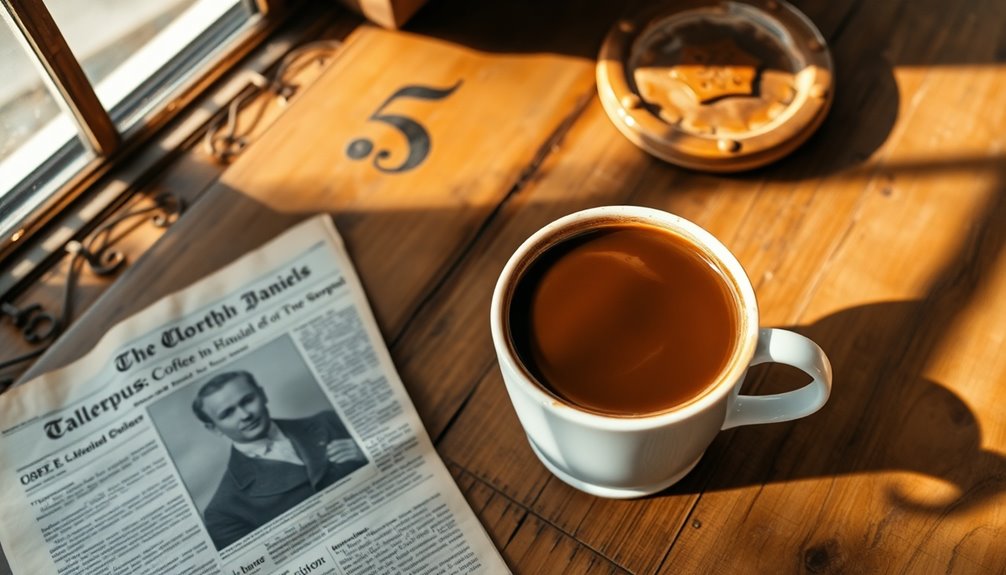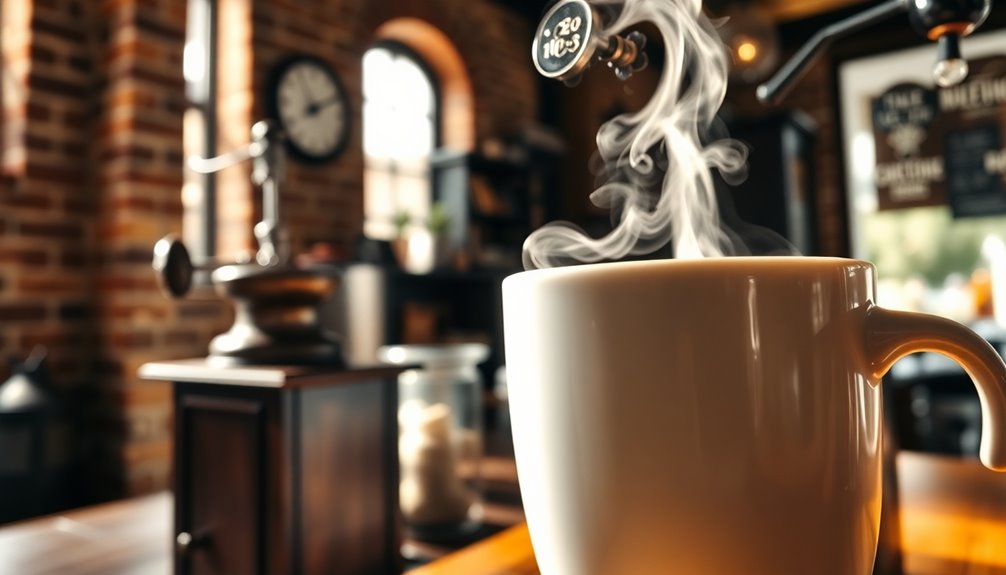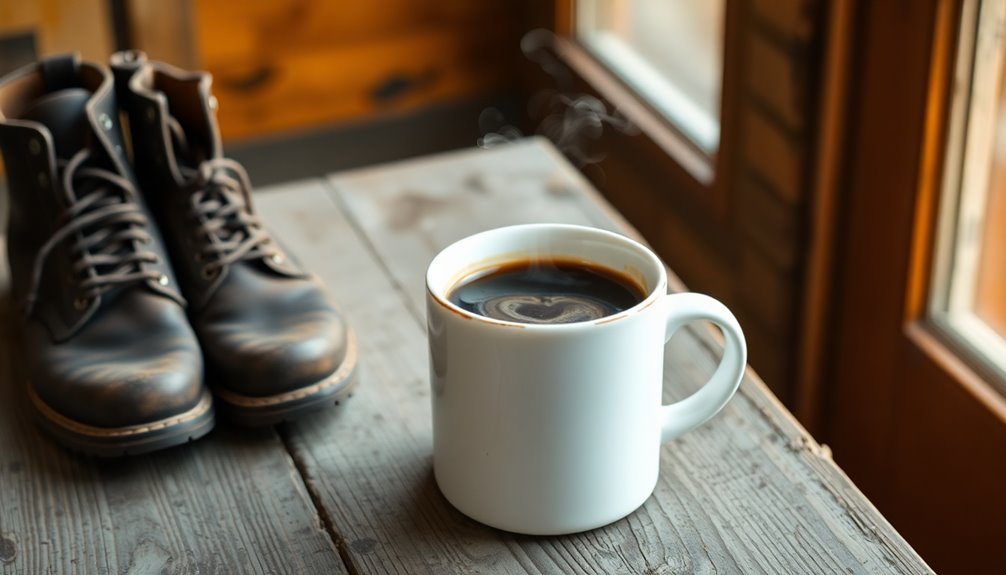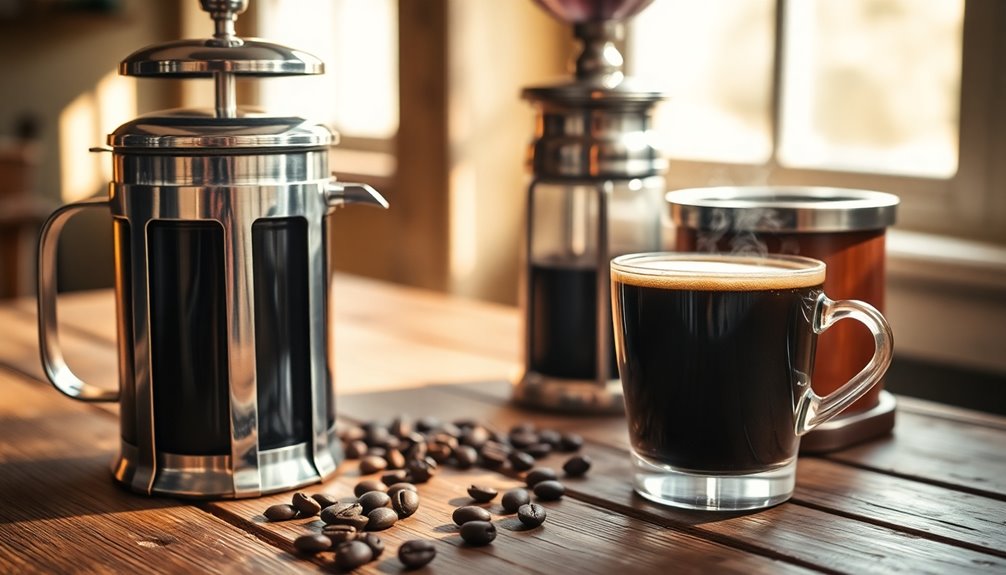The term "a cup of joe" likely traces back to Josephus Daniels, who banned alcohol on naval ships during World War I, prompting sailors to turn to coffee. This drink became a military staple, eventually earning its nickname in the 1930s. Another theory links it to the coffee brand Martinson, founded by Joe Martinson. Additionally, the slang term "jamoke," a mix of java and mocha, hints at coffee's cultural evolution. As coffee grew in popularity, it became the average man's drink, embedded in American life. Discover the layers behind this beloved beverage's rich history to know more.
Key Takeaways
- The term "cup of joe" likely emerged during World War I when sailors turned to coffee after alcohol was banned on naval ships.
- Josephus Daniels' 1914 General Order 99 prohibited alcohol, leading to coffee's rise as the primary beverage for sailors.
- The first recorded instance of "cup of joe" appeared in 1931, suggesting a more recent origin than previously thought.
- "Jamoke," a blend of "java" and "mocha," reflects earlier slang for coffee and may have influenced the term's evolution.
- Coffee became a symbol of American patriotism and comfort, replacing tea and alcohol as a popular beverage throughout history.
Theories About Josephus Daniels

One compelling theory about the origin of the term "cup of joe" links it to Josephus Daniels, the Secretary of the Navy during Woodrow Wilson's presidency.
In 1914, Daniels issued General Order 99, banning alcohol on naval property to improve moral standards. This decision led sailors to turn to coffee, as it became the strongest available beverage on ships. During World War I, coffee was often the only fresh beverage available to sailors, solidifying its role as a military staple.
While the ban sparked a significant increase in coffee consumption, sailors didn't always embrace this change. They'd traded their beloved drinks for what became an essential ritual.
However, critics point out that the term "cup of joe" didn't appear until the 1930s, raising doubts about this theory's validity and leaving room for alternative explanations regarding the term's true origin.
Connection to Martinson Coffee

The connection between the term “cup of joe” and Martinson Coffee is significant, as the brand played a crucial role in popularizing the phrase. Founded in 1898 by Joe Martinson, this company began its journey in a small kitchen, quickly gaining a devoted following for its unique roasting and blending methods. By roasting each type of bean separately, Martinson Coffee ensured unmatched flavor and consistency, setting it apart from competitors. The brand’s innovative marketing strategies, including delivering coffee in Rolls Royces and aerial advertising, further enhanced its image of quality. Additionally, Martinson Coffee’s commitment to sustainable sourcing has helped maintain its reputation and connect with environmentally conscious consumers. Over time, the term “cup of joe” became synonymous with Martinson Coffee, cementing its legacy in the coffee world and contributing to its enduring popularity. In addition to its roasting methods, Martinson Coffee also introduced innovative flavors, such as roasting chicory root at home, which further solidified its reputation as a trailblazer in the coffee industry. This commitment to creativity and quality has allowed Martinson Coffee to withstand the test of time and remain a beloved choice for coffee enthusiasts around the world. The lasting impact of Martinson Coffee is evident in the continued use of the term “cup of joe” and the brand’s enduring popularity.
Linguistic Evolution of "Jamoke"

While Martinson Coffee popularized the phrase "cup of joe," another term, "jamoke," emerged around the same time, reflecting the rich linguistic evolution tied to coffee culture.
This term surfaced in the late 19th century as a blend of "java" and "mocha," initially used to refer to coffee. In nautical and military settings, it sometimes described someone with the color or intellect of coffee.
By the 1920s, "jamoke" evolved into slang for an inconsequential fellow, particularly during World War I, where it labeled soldiers lacking mental acuity. Interestingly, the term's transition from coffee to describing someone lacking intelligence showcases the dynamic nature of language.
The spelling shifted to "jamoke" in the 1940s, and today, it still denotes a foolish person while occasionally serving as a neutral term for "guy" or "man."
Coffee as the Average Man's Drink

Coffee has long been considered the drink of the average man, especially in America, where its rise to popularity marked significant cultural shifts.
During the American War of Independence, coffee replaced tea as a patriotic symbol, solidifying its status. By the 1830s, it surpassed tea as America's favorite hot beverage, thanks in part to the temperance movement promoting coffee over alcohol. Additionally, coffee is often viewed as a source of antioxidants, contributing to its appeal among health-conscious consumers.
Soldiers relied on coffee during both World Wars for alertness and morale, while soup kitchens served it during the Great Depression, offering comfort amid hardship. The emergence of coffeehouses as sober social spaces further embedded coffee into the American fabric.
Today, it remains a daily ritual for many, reflecting its enduring role as the quintessential drink for the average man.
Historical Timeline of Usage

As you explore the historical timeline of coffee's usage, you'll find that its evolution is deeply intertwined with cultural shifts and societal changes.
The term "cup of joe" likely emerged from World War I, when Josephus Daniels banned alcohol, boosting coffee rations for sailors. However, the first recorded instance of the term appeared in 1931.
Before this, "jamoke," a mix of "java" and "mocha," hinted at coffee's earlier names. The military's use of instant coffee further popularized the term, with sailors playing a significant role in its spread. Additionally, the cultural significance of coffee consumption has evolved over centuries, reflecting its integration into various societies around the world.
Frequently Asked Questions
What Does "Cup of Joe" Mean in Coffee Culture?
In coffee culture, "cup of joe" refers to a regular, uncomplicated cup of coffee. It embodies a daily ritual that many people rely on for comfort and energy.
This term resonates with you as it connects you to shared experiences with others, whether at home or in a café. It represents the warm familiarity of enjoying coffee, transcending social and economic boundaries to become a beloved staple in many lives.
Are There Any Other Nicknames for Coffee?
Absolutely! Coffee has a ton of nicknames that reflect its energy-boosting qualities and flavors.
You might hear it called "go juice" for that morning kick or "jitter juice" when you need a caffeine boost.
Some folks refer to it as "mud" or "bean juice," highlighting its rich texture.
If you're looking for something stronger, "high octane" or "rocket fuel" might be your go-to terms.
There's always a perfect nickname for your cup!
How Has Coffee Consumption Changed Over the Years?
Coffee consumption has seen dramatic shifts over the years. You might notice that per capita consumption peaked in 1946 but declined post-WWII, partly due to the rise of carbonated drinks.
However, recently, it's on the upswing again, with 66% of Americans enjoying coffee daily as of 2022.
You can also see a growing trend in specialty coffees and espresso-based drinks, reflecting changing tastes and lifestyles in today's society.
Why Is Coffee Popular in American Diners?
Coffee's popularity in American diners stems from its comforting and energizing qualities.
When you grab a cup, you're not just enjoying a drink; you're partaking in a social ritual that brings people together. Diners offer a casual atmosphere where you can savor rich flavors and catch up with friends.
Plus, the affordability and accessibility of coffee make it a staple for everyone, enhancing the overall dining experience and creating lasting memories.
What Is the Significance of Coffee in Military History?
Coffee holds immense significance in military history. It boosts morale, keeps troops alert, and fosters camaraderie among soldiers.
You'll find it replaced alcohol rations to maintain discipline and energized troops during long missions. From World War I to the Iraq War, coffee's been a staple in soldiers' diets, offering warmth and comfort in challenging environments.
It's not just a drink; it's a symbol of determination and a vital part of military life.
Conclusion
So, next time you sip your cup of joe, you can appreciate the fascinating history behind the name. Whether it's tied to Josephus Daniels, the Martinson Coffee Company, or the evolution of "jamoke," coffee truly embodies the spirit of the average person. Its journey reflects cultural shifts and language changes, making your drink not just a source of caffeine, but a story in a cup. Cheers to the rich history brewing in every sip!










